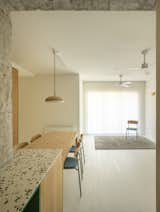PRINCIPE I Apartment in the Sant Andreu district of Barcelona
Details
Credits
From Nook Architects
This family home had been passed down from the previous generation to the current generation just as it had been
built in the 1970s. The current inhabitants therefore had a clear picture of its strengths and weaknesses, as well as
their objectives when refurbishing the dwelling. The aim of the intervention focused on simplifying the spaces and
connections, making the home more spacious and improving not only its functionality but also its natural light, which
was poor in places.
The layout was modified without compromising the original position of the different parts, forming two larger and
brighter bedrooms out of the original three. The kitchen was given a more open floorplan, yet still within its own
defined area, creating one single space together with the lounge-dining room and a larger opening to the outside.
This helped optimise the cross-ventilation and natural light throughout the living area.
The bathroom’s new location, strategically placed immediately after the gallery, serves to channel natural light
from the inner courtyard into the bedroom. Here, the light is tempered by a fluted glass divider, with a curtain that
provides total darkness when needed. The bathroom’s interior layout enables it to be used by several people at
once and allows for two-way circulation to and from the dressing room and master bedroom.
The colour scheme needed to be daring, bright and eye-catching. Inspired in the colours of Pop Art, the colour
palette was applied in specific areas, bringing to the fore the spaces that received the biggest makeover: the
kitchen, bathroom and dressing room. As a counterpoint, efforts were made to preserve the original materiality of
the structural concrete beams and columns, which, alongside the white-stained oak flooring, sustain and bring peace
to the interior design.
The refurbishment helped breathe new life into the spaces, which were redesigned with the new generation in mind,
enhancing the visual flow and questioning the traditional hierarchy of the home’s interior.














